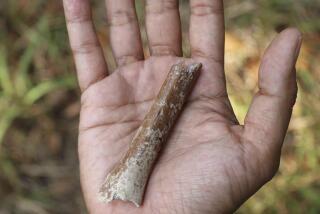Humans’ Ancestral Tree Adds a Twig
On an isolated Indonesian island, scientists have discovered skeletons of a previously unknown human species -- tiny, Hobbit-sized figures who lived among dwarf elephants and giant lizards as recently as 12,000 years ago.
Experts in human origins called the discovery, made public Wednesday, of an extinct human species barely 3 feet tall the most important -- and surprising -- human find in the last 50 years.
“It is probably the most significant thing that has happened in my professional lifetime,” said George Washington University paleoanthropologist Bernard Wood. “It comes out of nowhere.”
Found last year in a deep cave on an island called Flores east of Java, the creatures had the smallest brains and shortest bodies of any known human relative of the last 4 million years. Yet, on the time scale of human beginnings, the skeletal remains were so new that the bones had yet to actually fossilize. The creatures lived at the same time as modern Homo sapiens.
Over the last 13 months, a team of Australian and Indonesian researchers led by paleoanthropologist Peter Brown at the University of New England in New South Wales, Australia, has excavated seven partial skeletons of men and women belonging to the small human species from a limestone cave called Liang Bua.
The discovery of Homo floresiensis, or Flores Man, as the species has been named, is powerful evidence of human diversity and the inexorable force of evolution, researchers said.
More important, it demonstrates that selective pressures of adaptation to changing circumstances forced humankind into a new mold even after people had acquired the rudiments of culture and tool use, several experts said.
The evidence of stone tools found near the remains suggests that this diminutive offshoot of humankind commanded fire, cooked, chiseled primitive knives and axes, hunted in groups and demonstrated other basic elements of human behavior despite their small brains, the researchers reported.
All told, it appears that, marooned on a jungle island, humanity took a giant step backward to survive.
“It challenges the whole idea of what it is that makes us human,” Chris Stringer, director of human origins at the Natural History Museum in London, said Wednesday at a news conference.
The most surprising thing about the Flores people, experts said, is how neatly the creatures fit into the pattern of evolutionary biology documented among other species, which in long-term isolation often breed into extremely large or small versions of their mainland relatives.
Flores was home to many creatures that had died off elsewhere, often transformed by interbreeding and natural selection into dwarf or giant forms. These included a pint-sized species of pachyderms, full-sized Komodo dragons, and an even larger species of giant lizard.
No one is certain how early humans reached its shores. Parts of Indonesia were once joined to the Asian mainland, but Flores and its neighboring islands have been isolated by hundreds of miles of ocean for 2.6 million years.
Its discoverers surmise that the dwarf species was descended from members of a much larger early human species called Homo erectus who somehow crossed the sea to first settle the area, perhaps by clinging to floating logs or in primitive skiffs. Once they landed, there was no easy way to leave the island.
Researchers said that competition for limited resources in the rain forests and rugged mountains of ancient Flores apparently favored the survival of ever smaller humans.
The first of the specimens to be found was an almost complete set of bones from a grown woman of the species, unearthed in September 2003. She measured 39 inches tall and had a brain measuring about 23 cubic inches, about the volume of a grapefruit, the researchers reported today in the journal Nature.
By comparison, fossils of Homo erectus from Africa and Asia indicate that those early humans were almost twice as tall, with brains up to 61 cubic inches in volume.
Based on a study of her teeth and upright stance, the researchers ruled out the possibility that the creatures were a species of Southeast Asian ape. Because of the species’ unusual brain size, they also eliminated the possibility that the creatures were simply pygmies of the modern human kind, who are not a separate species.
The skull and other anatomical features did place it squarely in the human family as an unusual mixture of the old and new, they said.
The Flores specimens date from as long ago as 95,000 years to as recently as 13,000 years ago. The researchers speculated that the entire population was wiped out after a massive volcanic eruption 12,000 years ago blanketed the region with ash.
Although modern humans had reached Australia by 45,000 years ago, there is currently no evidence of any overlap between modern humans and this species on Flores. The oldest evidence of modern humans on Flores dates from just after the eruption.
“The little [creatures] lived at Liang until about 12,000 years ago,” said archeologist and co-author Michael J. Morwood at the University of New England. “This is remarkably recent and overlaps by tens of thousands of years with modern humans in the region.”
Morwood speculated that “almost certainly” other such evolutionary variants of humanity would turn up in other parts of southeast Asia.
“It’s rare, extremely rare, to find a hitherto-unknown species of human living in the recent geological past,” said Richard Roberts, a member of the discovery team at the University of Wollongong in Australia. “Perhaps the far-flung Indonesian islands have acted as a series of independent ‘Noah’s arks,’ each with their own trademark endemic dwarfs and giants.”






